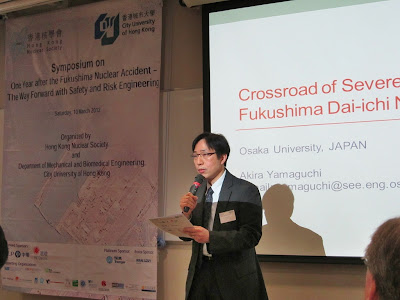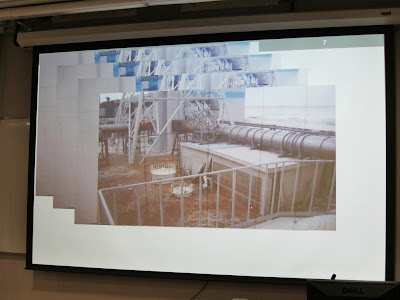The Symposium entitled “One Year after the Fukushima Nuclear Accident - the Way Forward with Safety and Risk Engineering”, which organized by Hong Kong Nuclear Society (HKNS) and the Department of Mechanical and Biomedical Engineering (MBE), City University of Hong Kong (CityU) on 10 March 2012. I represented Hong Kong Society for Quality (HKSQ) and America Society for Quality - Hong Kong Section (ASQ-HK), which were supporting organizations, to attend the symposium. As it was one year past the accident, the symposium was a timely event for experts from Japan, China, Taiwan, France and USA to share their knowledge on nuclear safety and risk engineering issues.

Dr. B.L. Luk (Chairman of HKNS) gave an opening and welcome note. He said the disastrous accident at the Fukushima Dai-ichi nuclear Power Plant in Japan had shocked the world and had drawn public concerns on nuclear safety. He would like to work with all the participants and supporting organizations together to enhance the nuclear literacy in Hong Kong and also provided constructive views and discussion on the way forward for the nuclear industry in this region.

Ir. Edmund KH Leung (Chairman of the Energy Advisory Committee) gave welcome speech. He introduced the important of nuclear safety and mentioned Daya Bay Contingency Plan in Hong Kong.

Then organizers took a photo with guest speakers, sponsors and supporting organizations respectively. (Photo showed all supporting organizations)

The first guest speaker was Prof. Akira Yamaguchi (Osaka University, Japan) and his topic entitled "Crossroad or Severe Accident in the Fukushima Dai-ichi NPP Accident".

Firstly, he explained the earthquake sources and the location of different nuclear power plant (NPP).

The second photo showed the movement level on each NPP. Eventhough the movement (from east to west - red in color) exceed the limit of Fukushima Dai-ichi unit 2, 3 &5, there were still in normal operation.

But the Tsunami Flood level exceed both the design high and site evaluation high that caused the big problem.

The photo was taken in the plant during Tsunami Flood.

The Tsunami submergence diagram was showed.

The availability of electrical equipment in each unit was indicated in the following table. Most of units were no power any more.

After that Prof. Akira Yamaguchi briefed the structure of Boiling Water Reactor Mk-I type.

He explained the operation failure had not happened after Earthquake but the NPP was malfunction after Tsunami and DC battery depletion in the following three diagram.



He described the accident progression through event tree.

There were three turning points for accident termination below:
First turning point: March 12, 15:36
- Hydrogen explosion in Unit 1
- Accessibility is lost
- Emergency preparation lost
Second turning point: March 16 or 17
- Reactor core of units 1, 2 and 3 are cooled by sea water injection by fire engine
- Started spent fuel pool cooling
- Although many problems remained, cooling of reactor core and spent fuel pool becomes foreseeable
Third turning point: March 22
- Started to use feed water system to cool down the reactor core
- Temperature decreased from 400C to less than 200C
- Risk of additional radioactive release is small
Prof. Akira Yamaguchi showed the recent photos of plant recovery operation.

The design approaches based on probabilistic and deterministic were mentioned to enhance the safety.

Finally, Prof. Akira Yamaguchi summarized that the accident sequence from "Earthquake and Tsunami" to "Station Black Out and Loss of Heat Sink" to "Hydrogen Explosion of Unit 1". He said medium to long term road map of consistent measures were performed on 21 Dec 2011. Looking for future, it needed to consider safety assessment, decommissioning and long term energy policy.
The second guest speaker was Dr. Bruce Hallbert (Idaho National Laboratory, USA) and his presentation named "Sensors Needs for Design Basis and Beyond Design Basis Harsh Environments".

Dr. Bruce Hallbert quoted the USNRC task force that "when ac power would not be available and the battery banks become depleted, functional failure would occur for nearly all instrumentation and control systems for monitoring critical parameters and operating critical systems that ensure that integrity of the fuel in the reactor and spent fuel pools and maintaining containment structures." And the accident sequence progression table was showed.

He said that existing sensors were / might be insufficient because of the followings:
- To withstand with assurance the environmental conditions and harsh environments;
- To cover the range of conditions that might be encountered
- To measure parameters needed for accident management and long-term plant recovery efforts
The example of pressure data in NPP was showed.

Then Dr. Bruce Hallbert mentioned the roadmap of nuclear energy research and development.

The mobile sensor was proposed to be developed for different environmental conditioins for accident monitoring.

At the end, Dr. Bruce Hallbert summarized that we learned about performance of sensors and instrumentation from Fukushima. Advances in Instrumentation and Control (I&C) technologies needed to address post accident management and long term recovery issues.
The third guest speaker was Dr. Tsu-Mu Kao (Institute of Nuclear Energy Research, Taiwan) and his presentation title was "Taiwan's Response and R&D Changes to Fukushima Dai-ichi NPP Accident in Japan".

Firstly, Dr. Tsu introduced the nuclear power plant (NPP) location and development plan to us.

He said the future of nuclear energy in Taiwan had the following major concerns:
- Earthquake, Tsunami
- Emergency planning zone and emergency framework, rescue capability
- The 4th NPP's (ABWR) reliability
- Public acceptance
- 2016 presidential campaign
Then he introduced the CARNEGIE papers entitled "Why Fukushima was preventable".

Defense-in-depth feature of Taipower NPPs was introduced that the water in reservoir could flow into reactor for cooling without use of electricity.

Ultimate response guideline (URG) flowchart was mentioned.

Finally, Dr. Tsu briefed the program of Taiwan's Nuclear Power Development.

Dr. Jean-Christophe Gariel (Environment Department, IRSN, Paris, France) was the forth guest speaker and his topic was "One year after: An Overview of the Consequences of Fukushima Dai-ichi Accident in France".

Dr. Jean-Christophe Gariel mentioned 58 nuclear reactors were operated in France. He also introduced the Institute for Radiological protection and Nuclear Safety (IRSN) which was a public body in charge of research, expertise and public service missions in the domain of the risk assessment related to nuclear activities.

The emergence preparedness was briefed using conceptual description of a nuclear accident.

The radioactive released in the atmosphere was measured and estimated.

Modelling of ambiant dose rate was performed for Fukushima Nuclear Accident. Then the simulation was enlarged to the global scale. (Diagram showed the atmospheric dispersion of Iodine)

Fukushima Dai-ichi accident was a "Shock" for both the nuclear industry and the public in France. A huge effort of transparency had been done by IRSN in order to provide real-time information to the public. Moreover, efforts were undertaken to improve the safety of existing installations and the emergency situations management. In France, we were debating on the evolution of energy mix.
Dr. Ren Jun Sheng (Nuclear Safety Expert Commission of the State Ministry of Environmental Protection, China) was the last guest speaker and his presentation was "Insights, Thoughts and Effects of the Fukushima Accident".

Dr. Ren summarized the origin of the accident that severe earthquake led to loss external electricity supply. Automatic reactor was shutdown after the earthquake, emergency diesel generators started automatically. But Tsunami flooded the buildings after about one hour, failing the emergency diesel generators, safety pumps, valves and other systems. Eventually, it led to a station blackout event (a beyond design basis accident). He also mentioned the national nuclear safety regulatory system was aligned with international standards.

It was based on IAEA conventions and standards.

The role of state organziations for nuclear safety was described below.

The initiation of an nuclear accidnents were analyzed in the following table.

Nuclear safety management on frequency and severity were discussed.

The operating commercial nuclear power plants in the Chinese mainland were covered 51% capacity.

Lastly, Dr. Ren said that Secretary General of CAEA Wang Yiren announced in the IAEA Ministerial Conference on nuclear security, which was held on 20 June 2011, that China would continue firmly to develop nuclear power on the basis of ensuring safety.
Discussion Forum chaired by Ms. Christine Loh (CEO, Civic Exchange).

Reference:
Hong Kong Nuclear Society (HKNS) - http://www.hkns.org.hk/home.html
Department of Mechanical and Biomedical Engineering (MBE), CityUHK - http://www.cityu.edu.hk/mbe/
Hong Kong Society for Quality (HKSQ) - http://www.hksq.org/index.asp
America Society for Quality (ASQ) - http://asq.org/index.aspx
HKSAR - Daya Bay Contingency Plan - http://www.dbcp.gov.hk/eng/dbcp/index.htm
A Decision to Make – Hong Kong’s Fukushima Lesson: Increase Nuclear Literacy - http://www.civic-exchange.org/wp/120308fukushima/
沒有留言:
發佈留言